TLR2/4 signaling pathway mediates sperm-induced inflammation in bovine endometrial epithelial cells in vitro
- PMID: 30995239
- PMCID: PMC6469758
- DOI: 10.1371/journal.pone.0214516
TLR2/4 signaling pathway mediates sperm-induced inflammation in bovine endometrial epithelial cells in vitro
Abstract
We have recently shown that sperm attachment to bovine endometrial epithelial cells (BEECs) triggers uterine local innate immunity with induction of a pro-inflammatory response in vitro, however details of the mechanism remain unknown. Here, we investigated the involvement of Toll-like receptor 2/4 (TLR2/4) pathway in mediating sperm-BEECs inflammatory process. Immunohistochemistry of the uterine tissue revealed that TLR2 and TLR4 proteins were present in the luminal and glandular epithelia of bovine endometrium. Moreover, BEECs monolayers were treated with TLR2 agonist (Pam; 0, 10, 100, and 1000 ng/ml) or TLR4 agonist (LPS; 0, 0.1, 1, and 10 ng/ml) for 0, 1, 3, or 6 h, followed by evaluating mRNA expression of the pro-inflammatory genes (TNFA, IL-1B, IL-8, and PGES) in BEECs using a real-time PCR. Both Pam and LPS treatments showed a dose-dependent stimulation of mRNA expression of the pro-inflammatory genes. To elucidate the functional role of TLR2/4 in sperm-BEECs interaction, BEECs monolayers were incubated with either TLR2 antagonist or TLR4 antibody for 2 h prior to the co-culture with sperm for 3 h. Importantly, pre-incubation of BEECs with TLR2 antagonist or TLR4 antibody prevented the stimulatory effect of sperm on the transcription of pro-inflammatory genes in BEECs. Furthermore, sperm increased the phosphorylation levels of TLR2/4 downstream targets (p38MAPK and JNK) in BEECs within 1 h of the co-culture. Treatment of BEECs with TLR2 antagonist prior to sperm addition inhibited JNK phosphorylation, while TLR4 antibody inhibited the phosphorylation of both p38MAPK and JNK. In conclusion, the present in vitro findings strongly suggest that bovine endometrial epithelial cells respond to sperm via TLR2/4 signal transduction.
Conflict of interest statement
The authors declare that there is no conflict of interest that could be preserved as prejudicing the impartiality of the research reported.
Figures
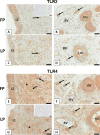
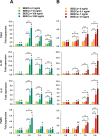

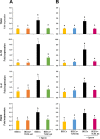

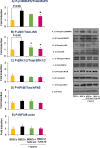
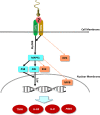
Similar articles
-
Hyaluronan regulates sperm-induced inflammatory response by enhancing sperm attachment to bovine endometrial epithelial cells via CD44: in-silico and in-vitro approaches.Front Endocrinol (Lausanne). 2023 May 10;14:1134868. doi: 10.3389/fendo.2023.1134868. eCollection 2023. Front Endocrinol (Lausanne). 2023. PMID: 37234812 Free PMC article.
-
Sperm activate TLR2/TLR1 heterodimerization to induce a weak proinflammatory response in the bovine uterus.Front Immunol. 2023 Apr 27;14:1158090. doi: 10.3389/fimmu.2023.1158090. eCollection 2023. Front Immunol. 2023. PMID: 37180107 Free PMC article.
-
Peptidoglycan Switches Off the TLR2-Mediated Sperm Recognition and Triggers Sperm Localization in the Bovine Endometrium.Front Immunol. 2021 Feb 11;11:619408. doi: 10.3389/fimmu.2020.619408. eCollection 2020. Front Immunol. 2021. PMID: 33643300 Free PMC article.
-
Modulation of Bovine Endometrial Cell Receptors and Signaling Pathways as a Nanotherapeutic Exploration against Dairy Cow Postpartum Endometritis.Animals (Basel). 2021 May 23;11(6):1516. doi: 10.3390/ani11061516. Animals (Basel). 2021. PMID: 34071093 Free PMC article. Review.
-
MicroRNAome: Potential and Veritable Immunomolecular Therapeutic and Diagnostic Baseline for Lingering Bovine Endometritis.Front Vet Sci. 2020 Dec 23;7:614054. doi: 10.3389/fvets.2020.614054. eCollection 2020. Front Vet Sci. 2020. PMID: 33426032 Free PMC article. Review.
Cited by
-
Mating to Intact, but Not Vasectomized, Males Elicits Changes in the Endometrial Transcriptome: Insights From the Bovine Model.Front Cell Dev Biol. 2020 Jul 10;8:547. doi: 10.3389/fcell.2020.00547. eCollection 2020. Front Cell Dev Biol. 2020. PMID: 32766237 Free PMC article.
-
Single-strain probiotics enhance growth, anti-pathogen immunity, and resistance to Nocardia seriolae in grey mullet (Mugil cephalus) via gut microbiota modulation.Anim Microbiome. 2024 Nov 19;6(1):67. doi: 10.1186/s42523-024-00353-0. Anim Microbiome. 2024. PMID: 39563419 Free PMC article.
-
Immune receptor toll-like receptor 4 contributes to stress-induced affective responses in a sex-specific manner.Brain Behav Immun Health. 2021 Mar 31;14:100248. doi: 10.1016/j.bbih.2021.100248. eCollection 2021 Jul. Brain Behav Immun Health. 2021. PMID: 34589759 Free PMC article.
-
Semen extender triggers a mild physiological inflammatory response in the uterus without disrupting sperm-uterine immune crosstalk in vitro in cattle.J Reprod Dev. 2025 Feb 5;71(1):24-34. doi: 10.1262/jrd.2024-093. Epub 2024 Dec 9. J Reprod Dev. 2025. PMID: 39647914 Free PMC article.
-
Effects of administration of mycobacterium cell wall fraction during the periovulatory period on embryo development following superovulation in virgin dairy heifers.JDS Commun. 2024 Feb 1;5(4):361-365. doi: 10.3168/jdsc.2023-0462. eCollection 2024 Jul. JDS Commun. 2024. PMID: 39220845 Free PMC article.
References
Publication types
MeSH terms
Substances
LinkOut - more resources
Full Text Sources
Research Materials
Miscellaneous

